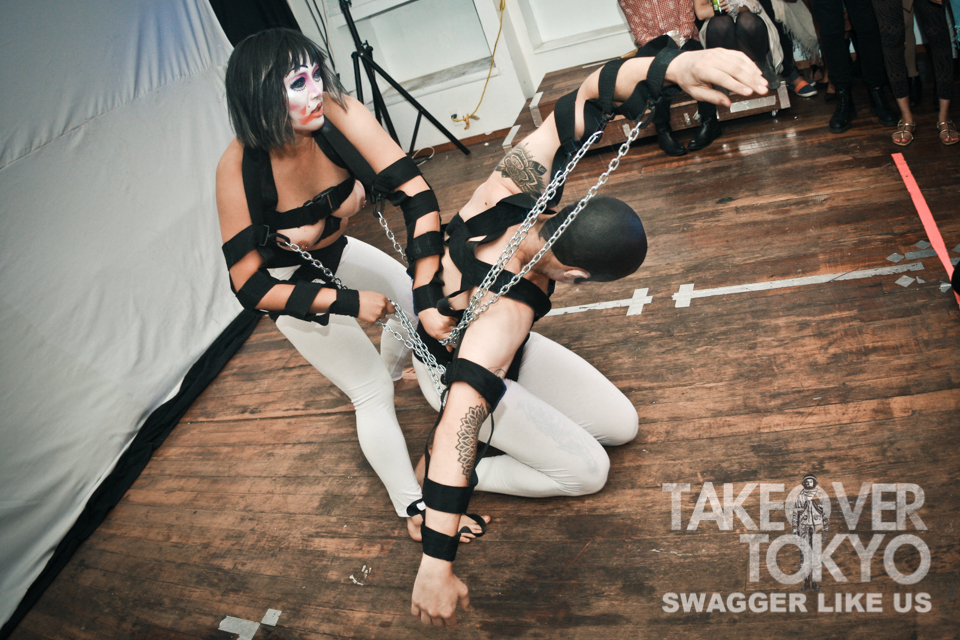Pseuda can be seen from a stage, holding two metal chain ropes attached to the limbs of another body. A doll, a dancer, Kim Ip. It’s Halloween, 2015, at B4bel4b Gallery, and the audience doesn’t yet know that Kim and Pseuda are chained together until they begin to stretch away, the chains syncing a nexus between bodies.
Kim is the marionette. She adorns a black, strappy makeshift harness fashioned of seatbelt material that cages her torso like external ribs. Attached to the back of her are the metal chains controlled by Pseuda. Kim struggles to escape the chained confines that contort and pivot her movements. Her improvised dance vocabulary avers free will against the puppeteering dominance of Pseuda, who expertly jostles Kim. Her master. Then the dominance inverts and the Doll can be seen controlling Pseuda. She throws them violently to the floor. “I’m Your Doll” by FKA Twigs accentuates the sparring as the movement fractures notions of control. The performer’s identities are exported and stretched in situ, surmising agency to that which was assumed to be a chained doll. But what traps the doll’s identity is the same mechanism that may set her free.

Nick Navarro’s drag identity —Pseuda —was born out of San Francisco’s SOMA nightlife milieu. While he never considered himself a performer, he frequented The Stud and rejoiced in queer mediations of identity. Pre-pandemic, the city’s queer nightlife aesthetics were a haven of experimental drag looks comprising the fabulous, the surreal, the abstract, the morbid –myriad identity transformations partying in unison. As Nick tells me, “Drag is an art form where you can literally do anything you want. The SOMA drag scene showed me there are no rules, and that was a big part of me discovering and making my queer identity.”
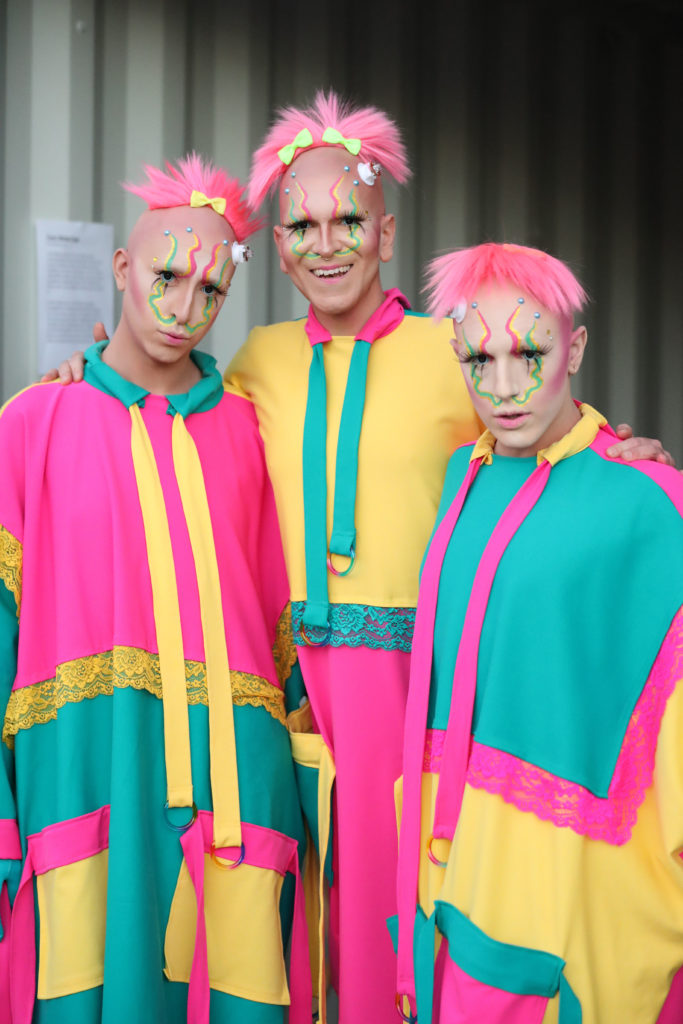
In 2014 Nick began experimenting with creepy horror drag concepts. Blacked out teeth and whiteout contacts. Dystopian characters and science fiction aesthetics. Blood and glitter. From there his alias, Pseuda, spawned and began performing throughout the city’s queer nightlife –often, alongside Jader and urheinous, as the offbeat drag trio Toxic Waste Face. One performance installation from the trio embodied them as zoned-out adult babies confined to wooden cribs glued to personal television monitors, complete with streams of incoherent media footage bleeding into one another. “We were embodying the crippling infantilization that technology can often wield over the human psyche through themes of technological isolation, control, the sort of phantom limb attachment to our devices,” Nick explains.
As an artist, Pseuda uses avatars to mediate their own identity to investigate the nefarious effects of technology on the human psyche, and our curation of the self.With Drag, Nick could embody anyone or anything he curated. Pseuda emerged as a self-evident slave to the ever-growing techno-voyeurism of digital media.


One night in 2016, Kim and Nick revealed new identity experiments in nightlife. Kim’s face and chest is covered in blood; Nick, layered in clownish white paint and dripping black makeup as one of the early horror-inspired Pseuda numbers. What ensued that night was a fabulously gruesome photo shoot atop a bed that memorialized their altered identities.
“As Nick, I was getting too in my head about how I was expressing myself online and whether it was too premeditated or actually represented my real identity. At a certain point, Nick left and Pseuda stayed.” With Nick’s emergent identities materializing across screens and stages throughout the country, he retired his personal Instagram account and curated a newfound persona. One where his relationship to digital media was a shadow of a hidden identity.
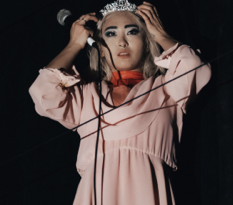
to her face with a microphone in one hand. She appears to be in a dark theater on a mezzanine.]
A year later, Kim & Nick collaborated on Steep in Here, as part of B4bel4b’s VITAL HYBRIDS performance showcase at Gray Area. In this work a large white cube enclosed dancers who moved within the confines of their contoured identities, while silhouettes ofother bodies were projected onto the white box. Shadows were emulating reality and attempting to learn from the dancers, as bewildered voyeurs in the audience tried to distinguish mediated outlines from their organic origin.
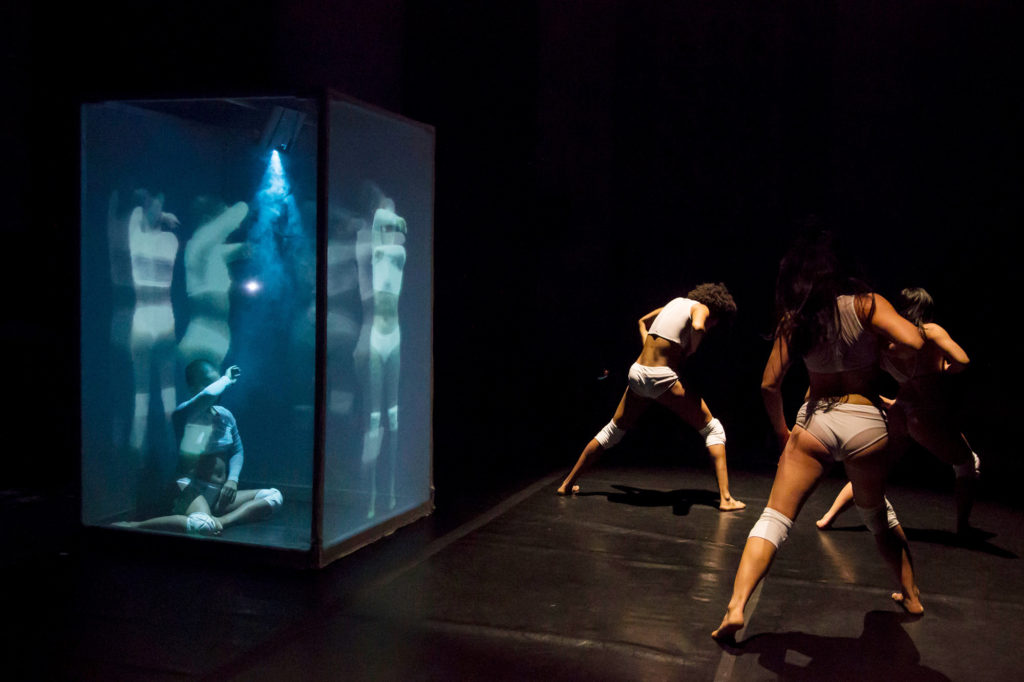
Kim’s work at B4bel4b foreshadowed future collaborations with Nick/Pseuda that examined the video vixens in our selfie camera.
Now, in March 2021 —a year into the pandemic —digital media’s voyeuristic capacity has expanded in deeper facets of everyday life. The new norm for many of us is to be devoid of live social interaction, and so we find deeper comfort in social media for the affirmation of our identities and our work. “There’s a value judgment that happens in my head,” Nick reflects, “Then I begin to analyze my work based on likes…it’s just strange. The struggle is to be liked and feel seen.”
“You have to also consider the tools that are being provided by the platform too,” Kim adds. “The tools on Instagram nurture an environment where we seek a semi celebrity status.”
As the pandemic progresses, so does use of social media. While some artists affirm the vitality of rest and stress the need to not strain our days for constant production; others constantly produce, share, and engage. Collaborations rehearse in virtual space, adapt, livestream their art with refreshed technological tools. And this output, as always, is saturated in the mass manufacturing of curated identities, (un)willingly mediated, manipulated, and stretched beyond that original post.
“We’re all watching our curated lives that we’re sharing with each other. We’re predicting the way we’re all watching each other, and unconsciously this alters how we engage with the world.” Nick observes. His vision of an augmenting techno-voyeurism evokes Neo in The Matrix, who wakes up in a pod of installed screens neighboring additional pods that span ad infinitum. “It’s what I call the microcosm. It’s a dystopian machinescape where we’re all individually isolated.” Identities in these pods are curated, distorted, and feedback endlessly to ourselves.
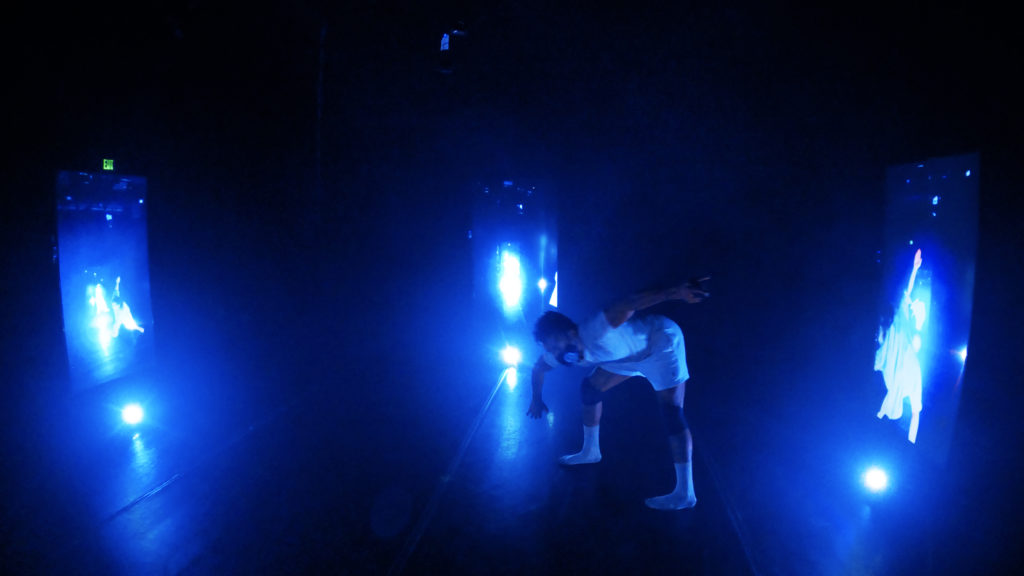
As the choreographer for are:era, Kim’s dance phrases mimic the dizzying replication of identity. “The challenge I felt was creating movements that were somehow dynamic enough but also fixed in space to not define the next dancers. It was like playing telephone with myself. When I’m doing the dance phrase, I need to subtly iterate my movement but not so much that it’s unrecognizable. It’s like your Facebook memory from years ago, like it’s me but also different. The dance sequence parallels your identity as it interfaces with social medias, maybe you lost track of your identity, you feel disoriented, or maybe you need to have someone remind you of who you are.”
The dancers —Kim Ip, Gabriel Christian, Erin Yen, and sibling hart —interface with phantoms of their mediated identities. Watching the work-in-progress, we view bodies move within a flicker of screens and try to trace an evolving identity. Embodying perhaps a single protagonist, the dancers mirror themselves, recoiling and leaping between screens. We hear the pulsating electronica score from urheinous. We see bodies bend in time and space, projected back to us, as dancers cypher through their morphing identity in cascading rhythm. Often they break free with a deviated movement, only to be captured by the technology and outputted into the echo chamber, infinitely. Performers are enveloped in a single crescendoing identity of light, music, and technology. Viewing the panopticon as an audience, the performance ascends into gorgeous chaos.
“The dancers are confined by these screens,” Nick describes. “And they’re literally trapped in this little installation where they watch each other. The lights black out, and when they come back you see a different dancer in the space, almost as if you, the audience member, have been transported to a different pod.” The time sequences of movement and projection are delayed, bodies disappear and reappear in space, identities merge and duplicate in multiplicity.
The chorographic elements in are:era emerged through Zoom rehearsals, a self-aware gridlock of dancers tracking each others’ movements. Dance scores were puzzle pieced into a collective work. “It was fascinating,” Kim recalls. “The rehearsals were a struggle of looking through ‘telephone footage’ and realizing that I’m seeing identities in front of me manipulated by each other. I’m seeing some kind of phenomena happening and I have no idea how to track any of this. It’s similar to sifting through massive online content and not knowing where you are.”
The screened collaborations evolved throughout the pandemic into socially distanced rehearsals at CounterPulse and Zoom call work-in-progresses. The Combustible Residency’s time frame doubled in length —a full year —to make space for generative expansion, from site to screen and back to site again. With are:era’s adaptation to an installation, it will exist beyond a screen as an evolving identity in and of itself.
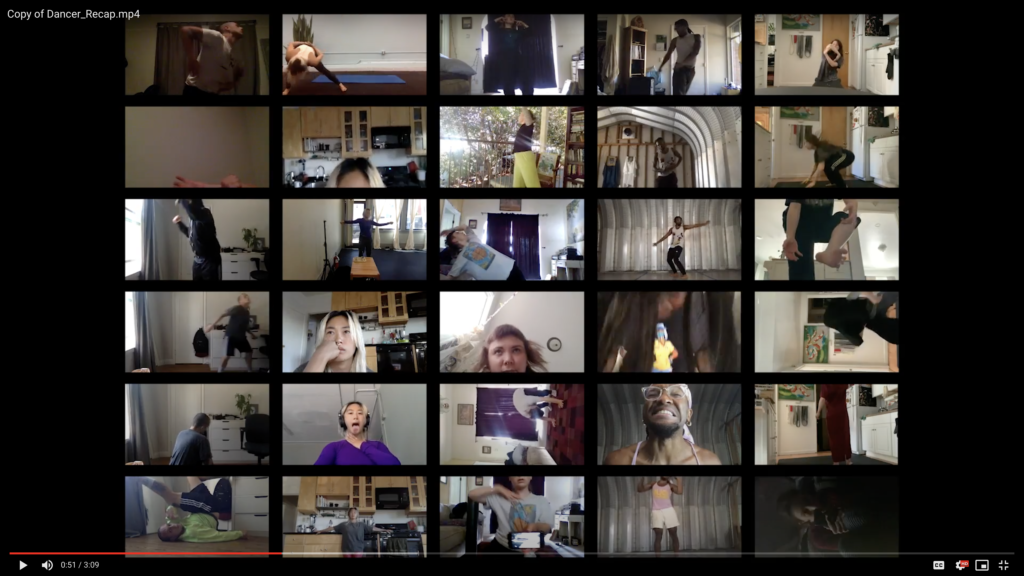
Nick and Kim don’t inherently prescribe pessimism to our techno-voyeurism stasis. “I don’t have a strong moral position but err on the side of skepticism,” Nick elaborates. “There are many good things like human connection, sharing resources, and the representation of different people. But all of these things are fed into the algorithms and tracked by the technology, and by us too.”
Three months into the New Year, artists and audiences continue to rely on social media to experience art, collaborate and connect, and observe one another. Arts institutions, too, ideate on novel digital engagement strategies, tracking cultural shifts; their branded identities, adapting. As many are increasingly reliant on digital tools, mental health and social media experts warn of the dangers of too much screen time. Numerous articles populate offering neurological explorations of Zoom fatigue and tips to alleviate the strain. Many feel oversaturated and delete their social media accounts for weeks.
Yet, as the protagonist of curated identities, social media users also find catharsis and a sense of belonging through digital participation. The same tools that entrap and mediate identities also spread vital resources and awareness, calls to action, and representation of marginalized individuals that can literally save lives.
Viewing Pseuda’s Instagram account, only one photo can be seen of Nick Navarro not in drag. The rest of the grid is an invigorating display of ghoulish looks, metal harnesses, algae wires, A.I, and electricity. In one video, Pseuda wears a helmet fashioned from barbed wire that wraps their head like a venus flytrap. Their torso is covered in a leather harness, and a beam of light is projection mapped to their chest —cracking open with changing shades of scarlet as they lip sync “Doomed” by Moses.
I feel you
But nobody else
Though you’re someone I can’t see
Yet you say nothing
Of the stoic suffering
That stirs lukewarm in me
If lovelessness is godlessness
Will you cast me to the wayside
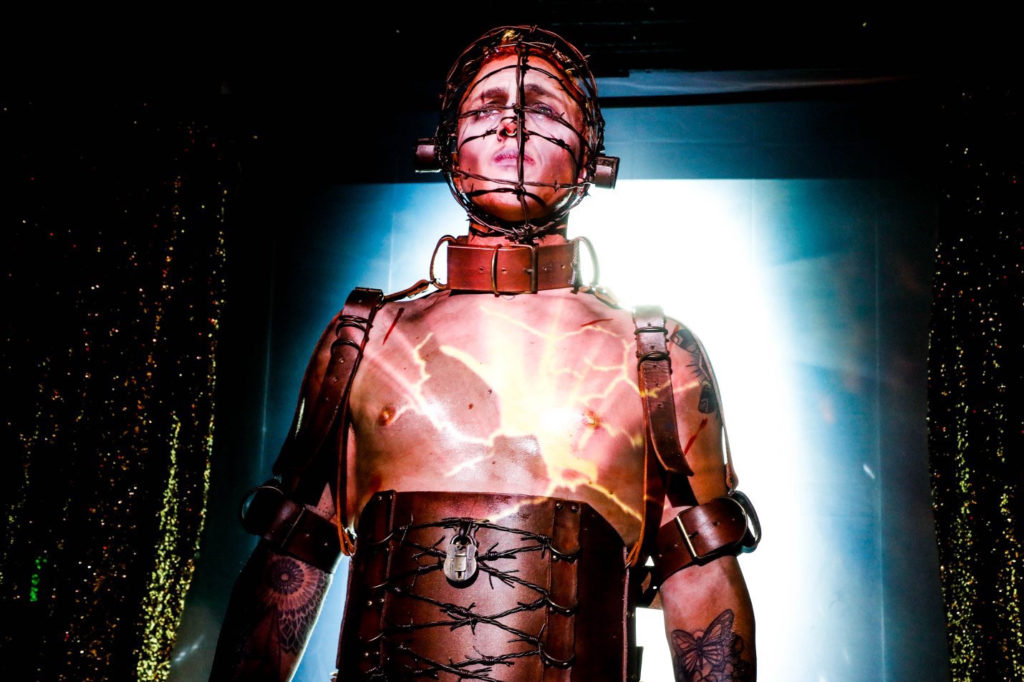
Not all of us can be science fiction drag artists or embody the mediated video vixen. Though Nick Navarro and Kim Ip’s work may compel us to rejoice in the nuanced identities of ourselves and others within the feedback loops we’re embedded in. With so much beyond our control in the emerging metaverse, how can we assert our known truths, or use the same tools that confine us to compose new optics of ourselves?
When the last dancer concludes their delay sequence, when the screens flicker the last ghost of an identity, when audiences leave the video installation, when are:era’s coda fades, we’ll be left to our own devices of introspection. Perhaps technology is merely a form of thought, and these same digital tools can recalibrate and choreograph new identities altogether.
are:era is part of a split bill with StratoFyzika for Combustible Residency 2021, running Wed-Sun, Apr 14-18, 12pm-8pm PST at CounterPulse. Live installation tours are available by appointment only, available at counterpulse.org/combustible2021.
A livestream and Q&A will air on Friday, April 16, 5pm PST
This article appeared in the Spring 2021 issue of In Dance.

